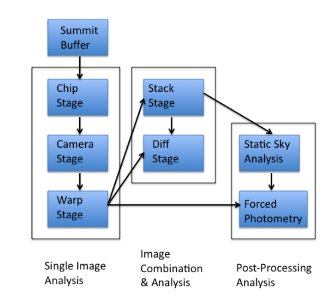PS1 data processing includes many steps to go from raw image data to the archived data products. The raw images are detrended to remove instrument signatures, and then deprojected into images in a regular grid of projection cells. These "warps" are then combined into "stacks." Various forms of point-source and extended-object photometry are performed on the warps and stacks.
The following information is taken from Magnier et al. and Waters et al., which should be cited appropriately. The starting point for the PS1 data archive is at Pan-STARRS1 data archive home page.
PS1 uses the 1.4 giga-pixel camera (see PS1 GPC1 camera) to image the sky north of declination −30 degrees. The camera detector system has 60 orthogonal transfer arrays (OTA) devices, each of which has an 8 × 8 grid of readout cells (each with 590×598 pixels). These images are reduced with the PS1 IPP pipeline. The Processing Version 3 (PV3) reduction, which all the publicly available data in this archive is based on, represents the third full reduction of the PS1 data set. The first two reductions were used internally for pipeline optimization and the development of the initial photometric and astrometric reference catalog, and are not publicly available.
For the PV3 processing, large contiguous regions were defined, and the images for all exposures within that region launched for the processing (see paper by Waters et al. for more details). The processing is divided into individual stages. The first step is the CHIP stage processing, which performs the PS1 Exposure detrending (e.g., bias subtraction, dark current correction, flat fielding, defringing, masking), as well as a single epoch photomety. Following the CHIP stage is the CAMERA stage, in which the astrometry and photometry for the entire exposure is calibrated by matching the detections against the reference catalog. This stage also performs masking updates based on the now-known positions and brightnesses of stars that create dynamic feature.
The WARP stage is the next to operate on the data, transforming the detector oriented chip stage images onto common sky oriented PS1 Warp images that have fixed sky projections. Point-source and extended source photometry is performed on these warps. When all WARP stage processing is done for the region of the sky, STACK processing is performed to construct deeper, fully populated PS1 Stack images from the set of warp images that cover that region of the sky. Source detection and photometry is performed on these stacks, which are then combined into objects (see PS1 Stack objects and photometry). Source detection and photometry is explained in more detail in the PS1 Source extraction and catalogs webpage.
Beyond the STACK stage, a series of additional stages are performed. Transient features are identified in the DIFF stage, which takes input warp and/or stack data and performs image differencing. Further photometry is performed in the STATICSKY and SKYCAL stages, which add extended source fitting to the point source photometry of objects detected in the stack images, and calibrate the results against the reference catalog. The FULLFORCE stage takes the catalog output of the skycal stage, and uses the objects detected in that to perform PS1 Forced photometry of sources on the individual warp images.
The PS1 Relative Photometric Calibration is determined by the photometric calibration algorithm of Schlafly et al. (2012), which refines the photometric calibration algorithm of Padmanabhan et al. (2008), used in the Sloan Digital Sky Survey. The throughput of the system is modeled with as a constant system throughput and atmospheric k-term each night. The model is determined by finding the parameters of the model that minimize the variance in flux of repeated observations of the same sources. The photometric calibration also simultaneously fits for a low resolution flat field correction vector and a trend in system throughput with PSF.
The PS1 Absolute photometric calibration combines the use of a laser diode system to accurately and precisely determine the filter bandpass edges and throughput curves (roughly to 7 A in mean effective wavelength), with the PS1 observations of HST Calspec standards.
The PS1 Astrometry is anchored with the Gaia astrometry.

Schematic of the images and analysis processing stage of the PS1 IPP pipeline, described in Magnier et al.
